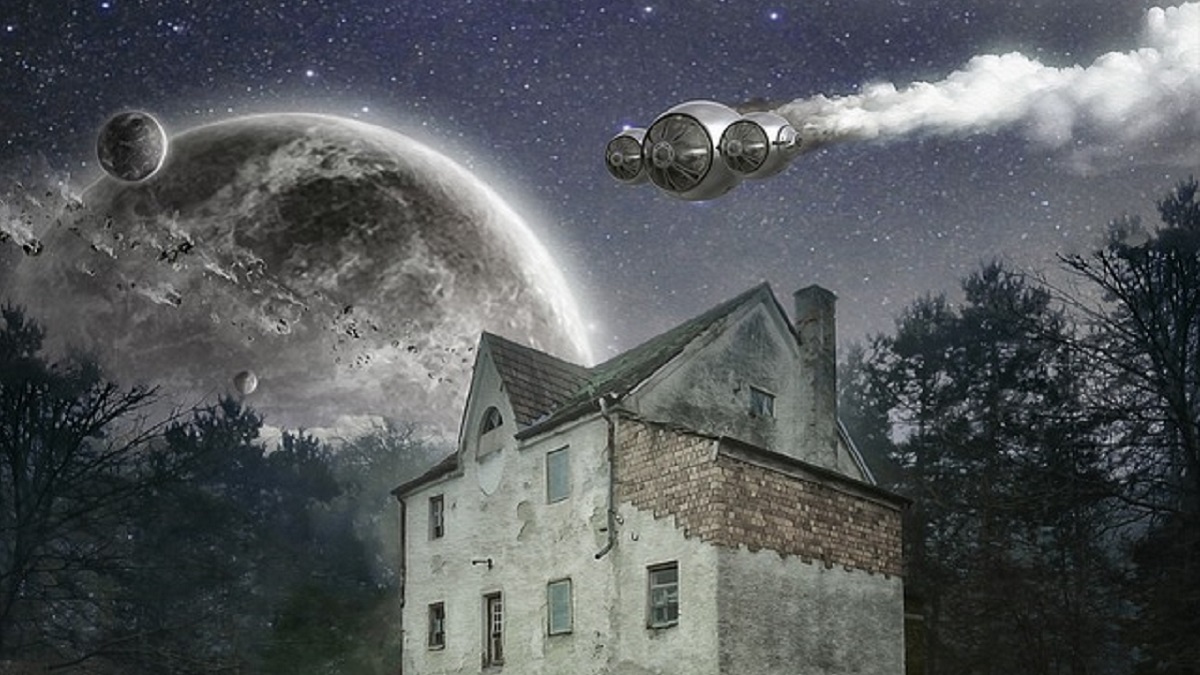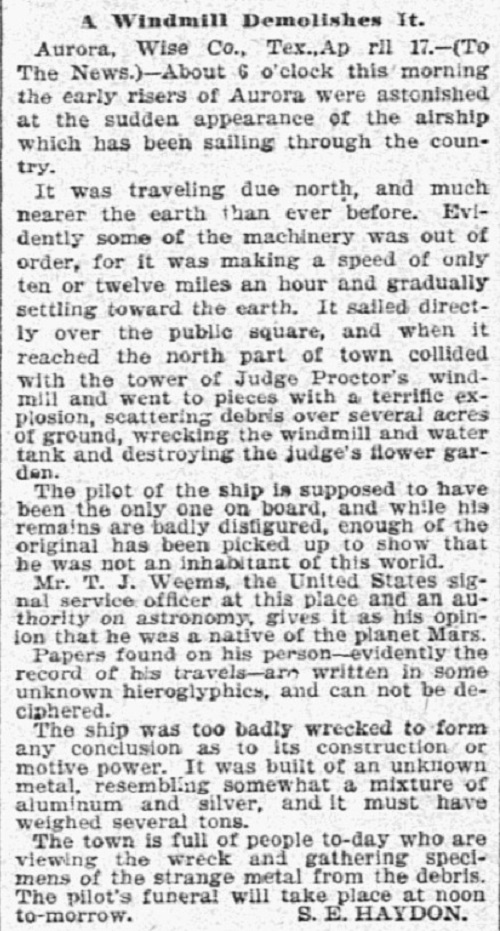
A UFO crash occured in Aurora, Texas in 1897. Pic credit: Pixabay
A U.S. Congressman suggested that government coverup of UFO information may have started as early as 1897 when the Aurora, Texas incident happened.
While speaking on the Event Horizon podcast, Representative Tim Burchett raised the possibility that the alleged coverup of information about extraterrestrials didn’t start with the 1947 Roswell UFO incident (see video below).
“We’ve been dealing [with this] at least since 1947… probably since about 1893… I believe [it] was Aurora, Texas… I think [that’s] when it [happened], I’m not sure…,” he said.
He claimed that alien UFO technology was more advanced than human technology. Evidence suggested that some UFOs travel faster than light and defy known laws of physics, according to the Congressman.
He also suggested that aliens could be from an ancient civilization that preceded humans. He speculated that the alien civilization behind UFO phenomena could be tens of thousands of years old.
What is the Aurora, Texas UFO incident?
The representative from Tennessee was wrong that the Aurora incident happened in 1893. It happened in 1897.
Many people are familiar with the July 1947 Roswell incident when an alleged flying saucer UFO crashed at a site near Corona in Lincoln County, New Mexico.
However, fewer people have heard about the Aurora UFO incident.
If you’ve been wondering what the Aurora, Texas UFO incident was about, here is what you need to know.
The Aurora incident happened in April 1897
What became known as the Aurora, Texas, UFO incident occurred on April 17, 1897.
Residents of Aurora in Wise County reported that a mysterious flying craft crashed on a property on the outskirts of the town.
Reports claimed that the pilot who died in the crash was non-human. Folklore alleged that locals buried the alleged alien at a cemetery in Aurora.
The Dallas Morning News reported on the UFO crash
The Dallas Morning News was the first to report the alleged incident. The April 17, 1897 report by S.E. Haydon (see text below) claimed that at about 6 a.m., residents noticed an “airship” sailing across the sky due north. It appeared to be losing altitude due to an engine malfunction.
The craft passed over the public square in the middle of the town northward, where it crashed into the tower of a windmill belonging to Judge Proctor.
The collision caused a catastrophic explosion that blew the craft apart, scattering debris over several acres of ground and causing extensive damage to the judge’s property.

The Dallas Morning News. April 17, 1897, page 5. “A Windmill Demolishes It” (Original article describing the Aurora UFO incident). Pic credit: via Wikipedia/Public Domain
The UFO pilot was “not an inhabitant of this world”
The report claimed that the pilot, who died in the crash, was “not an inhabitant of this world.”
It cited Mr. T.J. Weems of the U.S. Signal Service, who offered the “expert” opinion (being an “authority on astronomy”) that the pilot was a “native of the planet Mars.”
Responders also recovered documents from the craft written in a strange hieroglyphics-like script that no one could read. But the reporter guessed that the document contained an account of the pilot’s travels.
Description of the UFO craft
The closing paragraphs of the brief news report attempted a description of the mysterious craft.
The UFO was severely damaged. No one could determine its construction and propulsive mechanism. Haydon could only say that it consisted of a “strange metal” resembling an alloy of aluminium and silver.
He called the strange craft an “airship,” the commonly used term for dirigible balloons (steerable lighter-than-air-craft) in the 19th century.
Was there a coverup?
Some later claimed that the report was a hoax and that Haydon invented the story to promote tourism.
The claim that the story was a hoax followed a Time magazine report in 1979 in which Etta Pegues, a woman in her late 80s, claimed Haydon wrote the story as a prank.
However, subsequent investigators found that the woman was mistaken when she said there was never a windmill on the farm property.
Mutual UFO Network (MUFON) investigation
MUFON investigated the incident in 1973.
They visited the cemetery at Aurora and reported seeing a graver marker that depicted what looked like a flying saucer. The spot also registered readings on their metal detector that suggested a metallic object was buried in the grave.
However, the cemetery authorities refused to let them dig. There were later allegations that someone removed the marker. When MUFON returned to the site, the metal detector no longer detected the presence of metallic material in the grave, suggesting someone had removed it.
MUFON also interviewed a witness who claimed to have been a 10-year-old when the incident happened. The witness said he saw the craft passing overhead, trailing smoke.
Modern aviation was still in its infancy in 1897
To appreciate how striking the sight of an “airship” trailing smoke while crashing must have been to witnesses, remember that aviation technology was still in its infancy when the Aurora incident occurred. Dirigible balloons dominated the skies in the late 1800s, although pioneers (such as Otto Lilienthal and Percy Pilcher) were testing powered gliders and kites.
It wasn’t until 1903 that the Wright brothers, Orville and Wilbur, solved the “flying problem” and opened the modern aviation era. At Kill Devil Hills near Kitty Hawk, North Carolina, the brothers demonstrated the first controlled and sustained flight of a self-powered heavier-than-air aircraft.
In 1890, at Satory, France, Clément Ader achieved a brief, uncontrolled flight of a steam-powered fixed-wing aircraft (the Eole or Avon I).
The craft covered only 50 meters at a height of only 20 centimeters before it crashed. But it was a significant milestone because it represented the first time someone had achieved take-off of a powered airplane.
In 1896, a year before the Aurora incident, Samuel Pierpont Langley catapulted an unmanned engine-driven craft (Aerodrome No. 5) into the air from the Potomac River. It covered a distance of only 3,300 ft.
Later in the year, he flew another unmanned craft (Aerodrome No. 6) that covered 4,790 ft.
In 1897, the year the Aurora incident occurred, Ader tested the Avon III, a steam-powered monoplane equipped with a ruder.
Although he claimed that the Avion III covered a distance of 300 meters (980 ft), others disputed it, and his French military sponsors withdrew funding from his project.